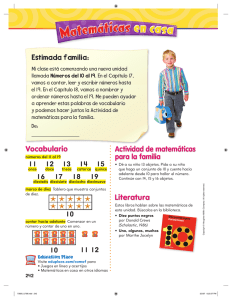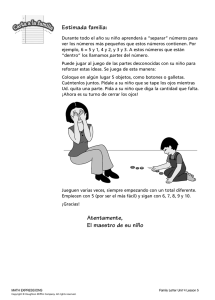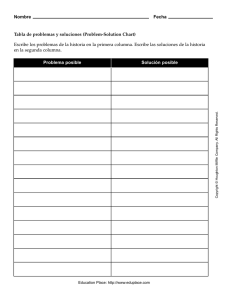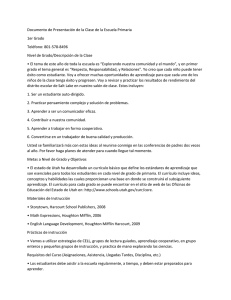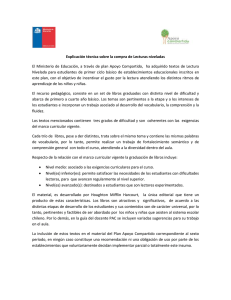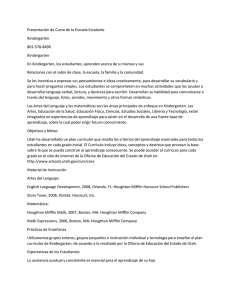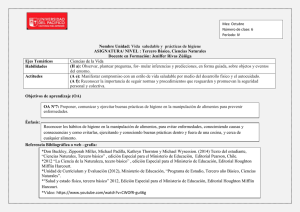Lugares calurosos - Houghton Mifflin Harcourt
Anuncio
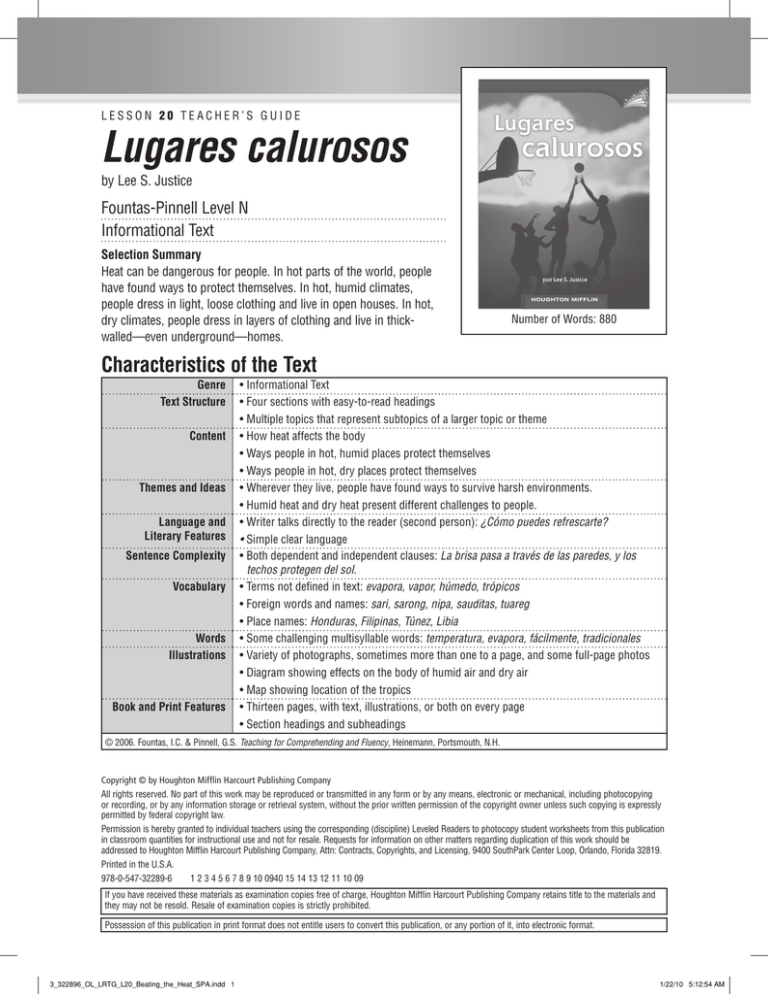
Nivel: Q EDL: 40 Género: Texto informativo Estrategia: Inferir/Predecir LESSON 20 TEACHER’S GUIDE Lugares calurosos Destreza: Idea principal y detalles Número de palabras: 957 3.4.5 by Lee S. Justice Fountas-Pinnell Level N Informational Text HOUGHTON MIFFLIN Libritos nivelados en línea Selection Summary Heat can be dangerous for people. In hot parts of the world, people have found ways to protect themselves. In hot, humid climates, people dress in light, loose clothing and live in open houses. In hot, dry climates, people dress in layers of clothing and live in thickwalled—even underground—homes. ISBN-13: 978-0-547-03722-6 ISBN-10: 0-547-03722-8 1033980 3_037226_LR4_5CV_Heat.indd 1 H O U G H T O N MI F F L I N Number of Words: 880 15/04/2008 11:08:26 Characteristics of the Text Genre Text Structure Content Themes and Ideas Language and Literary Features Sentence Complexity Vocabulary Words Illustrations Book and Print Features • Informational Text • Four sections with easy-to-read headings • Multiple topics that represent subtopics of a larger topic or theme • How heat affects the body • Ways people in hot, humid places protect themselves • Ways people in hot, dry places protect themselves • Wherever they live, people have found ways to survive harsh environments. • Humid heat and dry heat present different challenges to people. • Writer talks directly to the reader (second person): ¿Cómo puedes refrescarte? • Simple clear language • Both dependent and independent clauses: La brisa pasa a través de las paredes, y los techos protegen del sol. • Terms not defined in text: evapora, vapor, húmedo, trópicos • Foreign words and names: sari, sarong, nipa, sauditas, tuareg • Place names: Honduras, Filipinas, Túnez, Libia • Some challenging multisyllable words: temperatura, evapora, fácilmente, tradicionales • Variety of photographs, sometimes more than one to a page, and some full-page photos • Diagram showing effects on the body of humid air and dry air • Map showing location of the tropics • Thirteen pages, with text, illustrations, or both on every page • Section headings and subheadings © 2006. Fountas, I.C. & Pinnell, G.S. Teaching for Comprehending and Fluency, Heinemann, Portsmouth, N.H. Copyright © by Houghton Mifflin Harcourt Publishing Company All rights reserved. No part of this work may be reproduced or transmitted in any form or by any means, electronic or mechanical, including photocopying or recording, or by any information storage or retrieval system, without the prior written permission of the copyright owner unless such copying is expressly permitted by federal copyright law. Permission is hereby granted to individual teachers using the corresponding (discipline) Leveled Readers to photocopy student worksheets from this publication in classroom quantities for instructional use and not for resale. Requests for information on other matters regarding duplication of this work should be addressed to Houghton Mifflin Harcourt Publishing Company, Attn: Contracts, Copyrights, and Licensing, 9400 SouthPark Center Loop, Orlando, Florida 32819. Printed in the U.S.A. 978-0-547-32289-6 1 2 3 4 5 6 7 8 9 10 0940 15 14 13 12 11 10 09 If you have received these materials as examination copies free of charge, Houghton Mifflin Harcourt Publishing Company retains title to the materials and they may not be resold. Resale of examination copies is strictly prohibited. Possession of this publication in print format does not entitle users to convert this publication, or any portion of it, into electronic format. 3_322896_OL_LRTG_L20_Beating_the_Heat_SPA.indd 1 1/22/10 5:12:54 AM Lugares calurosos by Lee S. Justice Build Background Have students use their knowledge of how to keep cool in hot weather. Build interest by asking questions such as: ¿Qué es lo que más les gusta hacer en un día muy caluroso? Read the title and author and talk about the cover photograph. Discuss the idiom in the title. Tell students that this book is informational text, so the words and photos will give factual information about how people stay cool. Introduce the Text Guide students through the text, noting important ideas and helping with unfamiliar language and vocabulary. Here are some suggestions: Page 4: Have students turn to page 4 and read the heading. Point out that this section describes how heat affects people. Suggested language: ¿Qué hace el cuerpo cuando está muy caliente? ¿Por qué creen que sudan? ¿Qué podría pasar si tuvieran demasiado calor, o se sobrecalentaran? Page 6: Point out that this page has two headings. El encabezado rojo, “Lugares calurosos y húmedos”, es el encabezado principal. Dice de qué trata principalmente esta sección del libro. Un lugar húmedo tiene un clima, o un tiempo, con mucha humedad. El subtítulo negro, “Ropa fresca”, da información sobre el tema del encabezado principal. ¿Qué clase de ropa los mantiene frescos cuando hace calor? ¿Qué clase de ropa creen que usa la gente que vive en climas muy calurosos? Pages 10–11: Read the heading with students. Explain that this section of the book tells about hot places that are dry, not humid. ¿En qué creen que se diferencia la manera en que se visten y viven las personas de lugares calurosos y secos de la manera en que se visten y viven las personas de lugares calurosos y húmedos? Miren al hombre de la foto de la página 11. Lleva puestas varias capas, o grosores, de tela. ¿Les sorprende? ¡Hasta lleva puesta una tela en la cabeza! Ahora vuelvan al comienzo del libro para descubrir cómo afecta el calor a las personas y el modo en que se protegen de él en distintas partes del mundo. Target Vocabulary capa – grosor de algo, p. 10 constante – que no cambia, p. 8 clima – el tiempo promedio o típico de un lugar en especial, p. 6 desplazarse – moverse, p. 2 refugio – lugar donde vivir o protegerse, p. 9 inesperado – algo que pasa sin aviso, p. 10 región – área, división o distrito, p. 5 colonia – grupo de personas o de la misma clase de animales que viven juntos, p. 9 inhóspito – incómodas, desagradables, p. 10 sobrecalentar – estar tan caliente que no es seguro, p. 4 Grade 3 2 Lesson 20: Lugares calurosos © Houghton Mifflin Harcourt Publishing Company 3_322896_OL_LRTG_L20_Beating_the_Heat_SPA.indd 2 1/22/10 5:12:54 AM Read Have students read Lugares calurosos silently while you listen to individual students read. Support their problem solving and fluency as needed. Remind students to use the Infer/Predict Strategy figure out more about the selection. and to use clues to Discuss and Revisit the Text Personal Response Invite students to share their personal responses to the book. Suggested language: Si tuvieran que elegir, ¿preferirían vivir en un clima caluroso y húmedo o en un clima caluroso y seco? ¿Por qué? Ways of Thinking As you discuss the text, help students understand these points: Thinking Within the Text Thinking Beyond the Text Thinking About the Text • In hot weather, becoming overheated can be dangerous. • Hot climates are not all alike. • The photographs show examples of clothing and homes in both hot, humid and hot, dry climates. • People who live in hot, humid places wear light, loose clothing and live in open houses that let breezes through. • People who live in hot, dry places wear layers of clothing and live in thick-walled houses that keep the sun’s heat out. • Wherever they live, people find ways to protect themselves from harsh, hot weather. • People can adapt to many kinds of environments. • The headings and subheadings tell the reader what information will be presented in each part of the text. • The author includes many details about how people are affected by heat and how they protect themselves from it. © 2006. Fountas, I.C. & Pinnell, G.S. Teaching for Comprehending and Fluency, Heinemann, Portsmouth, N.H. Choices for Further Support • Fluency Invite students to choose a passage from the text and demonstrate phrased fluent reading. Remind them to vary the speed of their reading, slowing down when the text is more difficult and speeding up for easier parts. • Comprehension Based on your observations of the students’ reading and discussion, revisit parts of the text to clarify or extend comprehension. Remind students to go back to the text to support their ideas. • Phonics/Word Work Provide practice as needed with words and word parts, using examples from the text. Guide students to take apart and read words using their knowledge of open and closed syllables. For example, point out that vapor begins with an open syllable—one that ends in a vowel (va-por)—and the last syllable in trópicos is closed, ending in a consonant (tró-pi-cos). Have students look through the book and list more words of each type. (Examples: open—húmedo, clima, región; closed— sudor, alberca, desiertos). Grade 3 3 Lesson 20: Lugares calurosos © Houghton Mifflin Harcourt Publishing Company 3_322896_OL_LRTG_L20_Beating_the_Heat_SPA.indd 3 1/22/10 5:12:55 AM Writing about Reading Critical Thinking Have students complete the Razonamiento crítico questions on Hoja reproducible 20.7. Responding Have students complete the activities at the back of the book. Use the instruction below as needed to reinforce or extend understanding of the comprehension skill. Target Comprehension Skill Main Ideas and Details Remind students that as they read, they can identify important ideas and details about a topic. Model the skill, using a “Think Aloud” like the one below: Think Aloud Este libro contiene un montón de información, así que mientras leo, busco las ideas principales. Muchas veces, la idea principal está al principio de un párrafo. En la página 6, debajo del subtítulo “Ropa fresca”, leo que la gente que vive en los trópicos usa ropa holgada de colores claros. Esa es la idea más importante del párrafo. El párrafo me dice que la ropa holgada permite que el aire circule por el cuerpo, y el aire pasa fácilmente por esa tela. Esos son detalles sobre la idea principal. Practice the Skill Have students read the paragraph on page 8 and write the main idea. Then have them write details about the main idea. Writing Prompt: Thinking Beyond the Text Have students write a response to the prompt on page 6. Remind them that when they think beyond the text, they use what they know and their own experience to think about what happens in the story. Assessment Prompts • How do white clothing and white buildings help protect people from the heat? • Complete this sentence in your own words: From this book, the reader can tell that people who live in hot places __________________________________________. • Which words from the first paragraph on page 4 help the reader know the meaning of the word evapora? Grade 3 4 Lesson 20: Lugares calurosos © Houghton Mifflin Harcourt Publishing Company 3_322896_OL_LRTG_L20_Beating_the_Heat_SPA.indd 4 1/22/10 5:12:55 AM Responder DESTREZA CLAVE Idea principal y detalles Cierta ropa ayuda a la gente a mantenerse fresca en lugares húmedos y calurosos. Copia y completa el diagrama de abajo al agregar dos detalles que apoyen la idea principal. Idea principal La ropa ligera y holgada ayuda a la gente a mantenerse fresca. Detalle ¿? Detalle ¿? ¡A escribir! El texto y el mundo Escribe un párrafo persuasivo a la gente de tu pueblo o ciudad para que no hagan ejercicios cuando hace mucho calor. Algunas personas podrían estar en desacuerdo con esta idea. Incluye respuestas a los posibles argumentos. Lección 20 Nombre HOJA REPRODUCIBLE 20.7 Fecha Razonamiento crítico 15 Lugares calurosos Razonamiento crítico Lee y contesta las preguntas. 1. Piensa dentro del texto ¿Dónde están las regiones calurosas y húmedas de la Tierra? 3_037226_LR4_5OL_CALURO_L20.indd15 15 12/4/09 12:47:18 AM cerca del ecuador, en los trópicos 2. Piensa dentro del texto ¿Qué tipos de casas prefieren las personas que viven en lugares calurosos y secos? Respuesta posible: Prefieren las casas con paredes gruesas y ventanas pequeñas para mantener fuera el calor. 3. Piensa más allá del texto ¿Qué tipos de animales esperarías encontrar en un lugar caluroso y húmedo? ¿Y en un lugar caluroso y seco? Respuesta: En un lugar caluroso y húmedo podría encontrar animales selváticos, como las serpientes, los loros y los tigres. En un lugar caluroso y seco podría encontrar animales desérticos, como los camellos y las lagartijas. 4. Piensa acerca del texto ¿Preferirías vivir en lugar caluroso y húmedo o en un lugar caluroso y seco? ¿Por qué? Las respuestas variarán. Hacer conexiones ¿Cómo se compara el clima de tu zona con el clima de Lugares calurosos? ¿Es principalmente húmedo o seco? ¿Qué haces para mantenerte fresco cuando hace calor? Escribe tu respuesta en tu Cuaderno de lectura. Lea las instrucciones a los estudiantes. Razonamiento crítico 9 Grado 3, Unidad 4: Naturaleza grandiosa © Houghton Mifflin Harcourt Publishing Company. All rights reserved. 3_352916RTXSAN_U04_CT.indd 9 Grade 3 5 8/17/09 11:40:33 PM Lesson 20: Lugares calurosos © Houghton Mifflin Harcourt Publishing Company 3_322896_OL_LRTG_L20_Beating_the_Heat_SPA.indd 5 1/22/10 5:12:57 AM Nombre Fecha Lugares calurosos Pensar más allá del texto Piensa en las siguientes preguntas. Después escribe tu respuesta en uno o dos párrafos. En la última página del libro, el autor describe el Valle de la Muerte, donce se corre una maratón todos los veranos. ¿Por qué crees que el autor decidió incluir esta información en el libro? ¿Crees que es buena idea hacer esta maratón en un lugar tan caluroso en verano? ¿Por qué sí? ¿Por qué no? Grade 3 6 Lesson 20: Lugares calurosos © Houghton Mifflin Harcourt Publishing Company 3_322896_OL_LRTG_L20_Beating_the_Heat_SPA.indd 6 1/22/10 5:13:00 AM Lección 20 Nombre Fecha Razonamiento crítico HOJA REPRODUCIBLE 20.7 Lugares calurosos Razonamiento crítico Lee y contesta las preguntas. 1. Piensa dentro del texto ¿Dónde están las regiones calurosas y húmedas de la Tierra? 2. Piensa dentro del texto ¿Qué tipos de casas prefieren las personas que viven en lugares calurosos y secos? 3. Piensa más allá del texto ¿Qué tipos de animales esperarías encontrar en un lugar caluroso y húmedo? ¿Y en un lugar caluroso y seco? 4. Piensa acerca del texto ¿Preferirías vivir en lugar caluroso y húmedo o en un lugar caluroso y seco? ¿Por qué? Hacer conexiones ¿Cómo se compara el clima de tu zona con el clima de Lugares calurosos? ¿Es principalmente húmedo o seco? ¿Qué haces para mantenerte fresco cuando hace calor? Escribe tu respuesta en tu Cuaderno de lectura. Grade 3 7 Lesson 20: Lugares calurosos © Houghton Mifflin Harcourt Publishing Company 3_322896_OL_LRTG_L20_Beating_the_Heat_SPA.indd 7 1/23/10 5:53:46 AM Lección 20 Estudiante HOJA REPRODUCIBLE 20.10 Fecha Lugares calurosos Lugares calurosos Registro de lectura NIVEL N page 6 Selection Text Errors Self-Corrections Accuracy Rate Total SelfCorrections El ecuador es una línea imaginaria alrededor del centro de la Tierra. Al norte y al sur del ecuador hay regiones llamadas trópicos. La mayoría de los trópicos son cálidos durante todo el año. Estas regiones tienen épocas de mucha lluvia. Por eso los trópicos tienen un clima húmedo y caluroso. La gente que vive en los trópicos usa ropa holgada de colores claros. La ropa holgada permite que el aire circule por el cuerpo. Eso es más cómodo en el calor. La gente también usa ropa hecha de algodón. El aire puede pasar fácilmente por esa tela. Comments: (# words read correctly/98 × 100) % Read word correctly Code ✓ lobo Repeated word, sentence, or phrase ® Omission lobo lobo Grade 3 Behavior Error 0 0 1 8 Substitution Code lodo lobo 1 Self-corrects lodo sc lobo 0 Insertion el 1 Word told T lobo lobo Error 1416142 Behavior 1 Lesson 20: Lugares calurosos © Houghton Mifflin Harcourt Publishing Company 3_322896_OL_LRTG_L20_Beating_the_Heat_SPA.indd 8 1/23/10 5:53:48 AM
